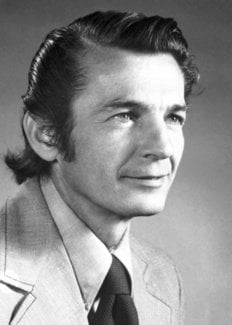Ivar Giaever
Biographical

Ivar Giaever was born in Bergen, Norway, April 5, 1929, the second of three children. He grew up in Toten where his father, John A. Giaever, was a pharmacist. He attended elementary school in Toten but received his secondary education in the city of Hamar. Next he worked one year at the Raufoss Munition Factories before entering the Norwegian Institute of Technology in 1948. He graduated in 1952 with a degree in mechanical engineering.
In 1953, Giaever completed his military duty as a corporal in the Norwegian Army, and thereafter he was employed for a year as a patent examiner for the Norwegian Government.
Giaever emigrated to Canada in 1954 and after a short period as an architect’s aide he joined Canadian General Electric’s Advanced Engineering Program. In 1956, he emigrated to the USA where he completed the General Electric Company’s A, B and C engineering courses. In these he worked in various assignments as an applied mathematician. He joined the General Electric Research and Development Center in 1958 and concurrently started to study physics at Rensselaer Polytechnical Institute where he obtained a Ph.D. degree in 1964.
From 1958 to 1969 Dr. Giaever worked in the fields of thin films, tunneling and superconductivity. In 1965 he was awarded the Oliver E. Buckley Prize for some pioneering work combining tunneling and superconductivity. In 1969 he received a Guggenheim Fellowship and thereupon spent one year in Cambridge, England studying biophysics. Since returning to the Research and Development Center in 1970, Dr. Giaever has spent most of his effort studying the behavior of protein molecules at solid surfaces. In recognition of his work he was elected a Coolidge fellow at General Electric in May, 1973.
Dr Giaever is a member of the Institute of Electrical and Electronic Engineers, and the Biophysical Society, and he is a Fellow of the American Physical Society. Dr. Giaever has served on committees for several international conferences and presently he is a member of the Executive Committee of the Solid State division in the American Physical Society.
Ivar Giaever married Inger Skramstad in 1952 and they have four children. He became a naturalized US citizen in 1964.
Notes added
Linus Pauling is reported to have said that the Nobel Prize did not change his life – he was already famous! That was not true for me. The Nobel Prize opened a lot of doors, but also provided me with many distractions. I have, however, continued to work in biophysics, attempting to use physical methods and thoughts to solve biological problems. At the present time, I am studying the motion of mammalian cells in tissue culture by growing both normal and cancerous cells on small electrodes.
I left General Electric in 1988 to become an Institute Professor at Rensselaer (RPI) in Troy, New York 12180-3590, and concurrently I am also a Professor at the University of Oslo, Norway, sponsored by STATOIL.
On a personal note my wife and I are now the proud grandparents of almost four grandchildren.
Ivar Giaever died on 20 June 2025.
This autobiography/biography was written at the time of the award and first published in the book series Les Prix Nobel. It was later edited and republished in Nobel Lectures. To cite this document, always state the source as shown above.
Nobel Prizes and laureates
Six prizes were awarded for achievements that have conferred the greatest benefit to humankind. The 14 laureates' work and discoveries range from quantum tunnelling to promoting democratic rights.
See them all presented here.
